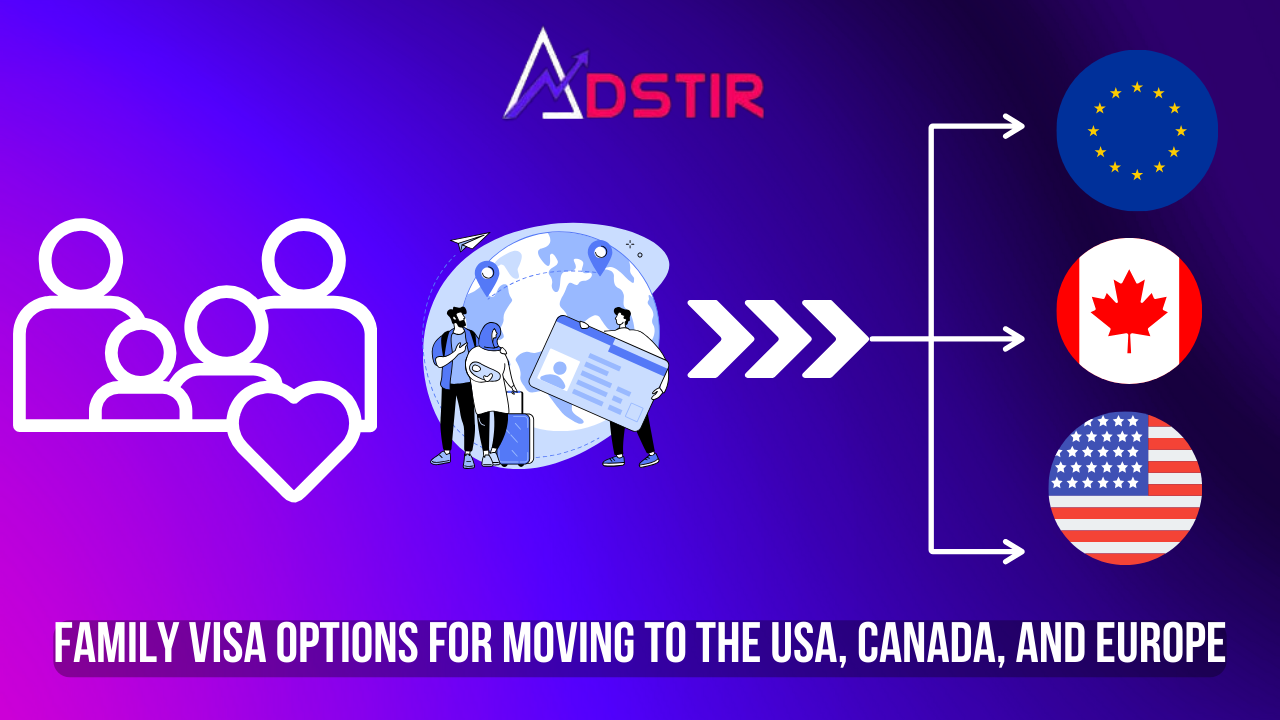Family Visa Options for Moving to the USA, Canada, and Europe – Moving to a new country is an exciting yet challenging process, especially when you want to bring your family along. Immigration policies vary from one country to another, and understanding family visa options can make the process smoother. The USA, Canada, and Europe offer different pathways for family reunification, each with its own eligibility requirements and procedures. This guide will help you navigate the options available in these regions, making it easier for you to plan your move.
Family Visa Options in the USA
The United States provides several visa options for families who wish to reunite. The most common pathways include family-sponsored visas and fiancé(e) visas. U.S. citizens and permanent residents can sponsor close family members through the Immediate Relative (IR) Visas and Family Preference Visas. Immediate relatives, such as spouses, children, and parents of U.S. citizens, receive priority and do not have a visa cap. However, family preference visas, which include siblings and married children, have annual limits and longer waiting times.
Another common option is the K-1 fiancé(e) visa, which allows a foreign fiancé(e) of a U.S. citizen to enter the country and get married within 90 days. After marriage, they can apply for a green card to become a permanent resident. Spouses of U.S. citizens or permanent residents can also apply for a CR-1 or IR-1 visa, allowing them to enter the country with permanent residency status.
Family Visa Options in Canada
Canada is known for its family-friendly immigration policies. The Family Sponsorship Program enables Canadian citizens and permanent residents to sponsor their spouses, common-law partners, dependent children, parents, and grandparents. Spousal sponsorship is divided into inland sponsorship, where the applicant is already in Canada, and outland sponsorship, where the applicant applies from outside Canada.
Canada also offers the Super Visa for parents and grandparents, allowing them to stay in the country for extended periods. Unlike a regular visitor visa, the Super Visa is valid for up to 10 years and allows multiple entries, making it an attractive option for family reunification.
Family Visa Options in Europe
Europe is home to many countries, each with its own immigration laws. However, many European nations, especially those in the Schengen Area, offer family reunification visas. The European Union (EU) Family Reunification Directive allows non-EU citizens to apply for family visas if they have a legal resident permit in an EU country.
In the United Kingdom, the Family Visa category enables individuals to join their spouse, partner, child, parent, or another close relative. For spouses and partners, proof of a genuine relationship and financial stability is required.
Germany has a Family Reunion Visa, allowing spouses, children, and sometimes parents of German residents to join them. Spouses must prove basic German language skills and demonstrate financial stability.
France offers a “Visa de Long Séjour” for family reunification, allowing spouses and children under 18 to join their family members in France. Applicants must prove they have suitable housing and financial means to support their family.
Italy, Spain, and other European countries also have family reunification options with similar requirements, such as proof of financial support, accommodation, and relationship authenticity.
Common Requirements for Family Visas
Although requirements vary, most family visa applications require the following:
- Proof of relationship (marriage certificate, birth certificate, etc.)
- Financial stability of the sponsor
- Medical examinations and background checks
- Language proficiency (in some cases)
- Adequate housing arrangements
Frequently Asked Questions (FAQs)
1. How long does it take to get a family visa?
Processing times vary by country and visa type. Immediate relative visas in the U.S. may take a few months, while family preference visas can take years. In Canada, spousal sponsorship applications typically take 12 months. European countries have processing times ranging from a few months to over a year.
2. Can I work while on a family visa?
In many cases, yes. Spouses of U.S. citizens can apply for a work permit while their green card application is pending. Canada allows sponsored spouses to work with an open work permit. In Europe, employment rights depend on the country, but many allow spouses to work once they receive residency status.
3. Do I need to know the language of the country I’m moving to?
Some countries, like Germany and France, require basic language proficiency for family reunification. Others, such as Canada and the U.S., do not have mandatory language requirements for family visa applicants.
4. What happens if my family visa application is denied?
If a family visa application is denied, you can usually appeal the decision or reapply with stronger supporting documents. Seeking legal advice or consulting an immigration expert can improve your chances of approval.
5. Can same gender couples apply for family visas?
Yes, in most countries that recognize same-sex marriages or partnerships, such as Canada, the U.S., and many European nations, same-sex couples can apply for family reunification visas.
Conclusion
Moving to the USA, Canada, or Europe with family requires careful planning and understanding of visa options. Each country has specific requirements, processing times, and eligibility criteria. Whether you are joining a spouse, sponsoring a child, or reuniting with parents, choosing the right visa pathway can make the process smoother. Seeking professional advice or thoroughly researching each country’s immigration laws can help you navigate the system effectively and reunite with your loved ones in a new home.
Also Read: Easiest Countries to Get a Work Visa Abroad in 2025
